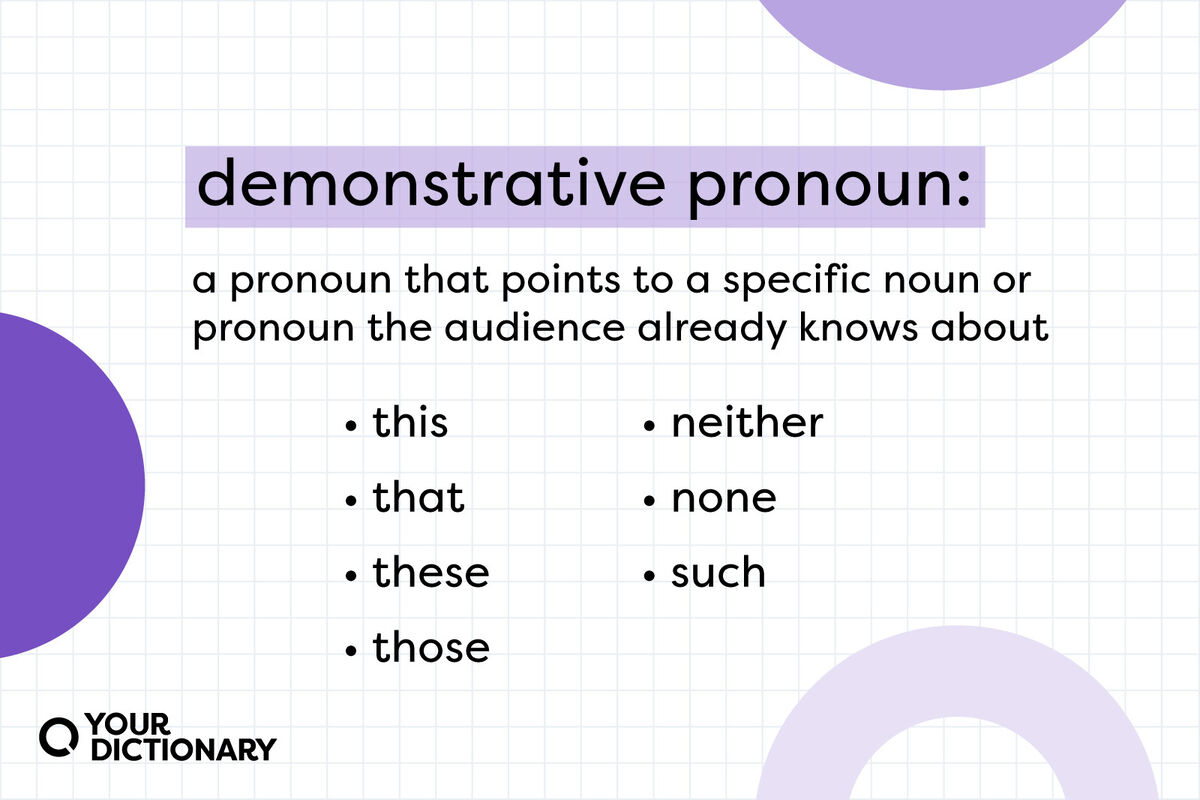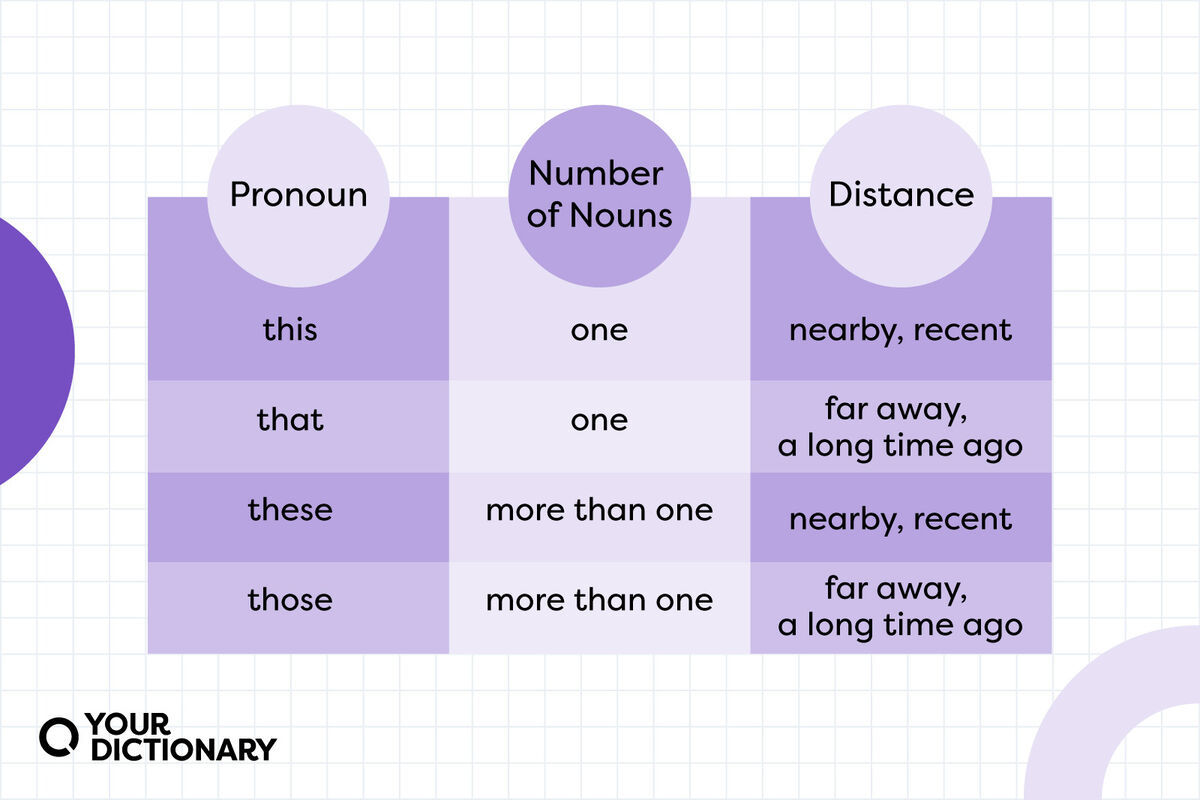
The word demonstrate may start with the word demon, but that doesn’t mean demonstrative pronouns are scary or evil. Quite the opposite — demonstrative pronouns are nice and helpful. You definitely want to keep demonstrative pronouns in your life (unlike any demons you may have hanging around).
What Is a Demonstrative Pronoun?
A demonstrative pronoun points to a noun or pronoun that the audience already knows about. Like all pronouns, demonstrative pronouns replace nouns — that way, you don’t need to repeat yourself.
- How did you know I wanted some candy? This really hits the spot. (This replaces candy)
- He got two cookies, and I got one. That isn’t fair. (That replaces the unfair action)
- I love apple pie and cherry pie. These are my favorite pies. (These replaces apple pie and cherry pie)
- Don’t eat the cookies in the bowl. Mom made those for me. (Those replaces cookies)
How Do Demonstrative Pronouns Work?
Sometimes the noun doesn’t appear beforehand, but the audience still knows what you’re talking about. Imagine a person pointing their finger at the thing (or things) they’re talking about in the following sentences, and you’ll have a demonstrative pronoun.
- That isn’t fair.
- This really hits the spot.
- These are my favorite pies.
- Those were all she needed.
List of Demonstrative Pronouns
The main demonstrative pronouns in English are:
- this
- that
- these
- those
- neither
- none
- such
So which one do you choose? It depends on how many nouns you’re talking about, and whether or not they’re close to you.

Other Words That Function as Demonstrative Pronouns
These indefinite pronouns can also function as demonstrative pronouns.
- neither - for choosing between two options
- none - for choosing between many options
- such - for pointing out a noun (same as this or that)
For example, in the sentence “The choice is between root beer and water,” you may say “I choose neither” — neither replaces root beer and water.
How To Use Demonstrative Pronouns
Though you may see a demonstrative pronoun’s antecedent in a sentence beforehand, it doesn’t always appear. Most times, you see demonstrative pronouns in a sentence when the audience already knows what the speaker is talking about.
Examples of Demonstrative Pronouns as Subjects
Demonstrative pronouns can function as the subject of a sentence (which performs the action in the verb).
- This is my plan.
- That doesn’t sound good.
- These are my favorites.
- Those taste the best.
Examples of Demonstrative Pronouns as Objects
When a demonstrative pronoun receives the action, it’s the object of a sentence.
- I knew all about this.
- No one told Barry about that.
- We bought these in Paris.
- You did a great job with those.
Examples of Demonstrative Pronouns in Questions
You can use this, that, these, and those in questions to get more information about something.
- Who is this?
- What is that?
- Whose are these?
- Which are those?
Examples of Demonstrative Pronouns To Introduce Nouns
When you use a demonstrative pronoun with the verb to be, you’re introducing a noun to your audience. Use this and these when the person or item is physically close to you, and use that and those when they’re farther away.
- This is my husband, Arnold.
- That’s my dog.
- These are my parents, Carl and Joanne.
- Those are my roommates.
Demonstrative Pronouns vs. Demonstrative Adjectives
This, that, these, and those (and neither, none, and such) can also function as demonstrative adjectives. But what’s the difference between demonstrative pronouns and demonstrative adjectives?
Like all adjectives, demonstrative adjectives describe nouns — they don’t replace them like demonstrative pronouns. They appear right before the noun they modify.
- Demonstrative adjective - That coffee smells delicious.
- Demonstrative pronoun - That smells delicious.
Demonstrative adjective - This yoga pose really hurts. - Demonstrative pronoun - This really hurts.
- Demonstrative adjective - Are these books yours or mine?
- Demonstrative pronoun - Are these yours or mine?
- Demonstrative adjective - Hand me those garden shears.
- Demonstrative pronoun - Hand me those.
Demonstrative Pronoun Quiz
Can you tell which sentences include demonstrative pronouns? (Hint: Some may be demonstrative adjectives instead.)
- Those roaches under our sink are totally gross.
- I don’t think my vote really counts. Such is the way of the world.
- These shoes smell disgusting; they’re just gross.
- That is my gym bag. I thought I lost it.
- I watched several old movies. Those old films are just incredible.
- Neither appeals to me.
Answer Key for Demonstrative Pronoun Quiz
Did you properly identify all the demonstrative pronouns?
- Those roaches under our sink are totally gross. (Demonstrative adjective describing roaches)
- I don’t think my vote really counts. Such is the way of the world. (Demonstrative pronoun)
- These shoes smell disgusting; they’re just gross. (Demonstrative adjective describing shoes)
- That is my gym bag. I thought I lost it. (Demonstrative pronoun)
- I watched several old movies. Those old films are just incredible. (Demonstrative adjective describing old films)
- Neither appeals to me. (Demonstrative pronoun)